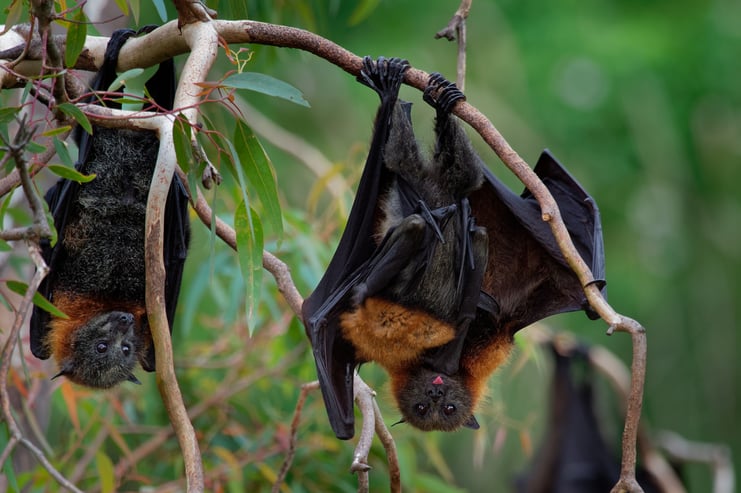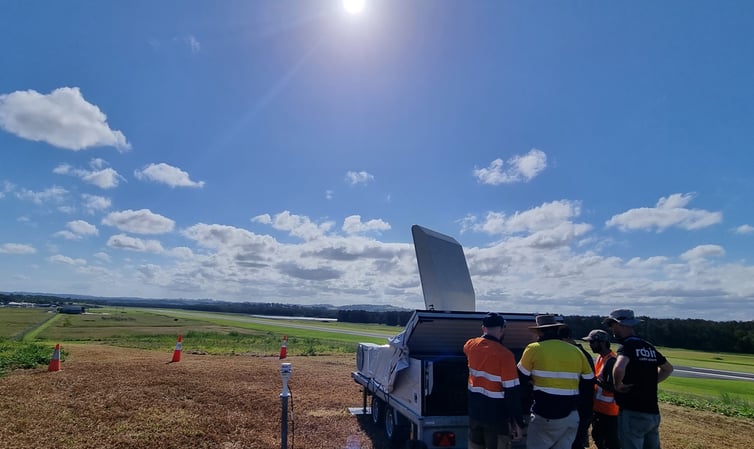Robin is collaborating with wildlife hazard management experts at Avisure and scientists at BatOneHealth for a pivotal study on flying foxes (or fruit bats) in New South Wales, Australia.
Now deployed on the other side of the globe, our flagship 3D radar, MAX, will support researchers studying the link between the loss of critical bat habitat and the spillover of viruses into other animals and humans.
It’s also the first project where MAX will be applied to study fruit bats. The radar delivers 3D, 360° awareness, 365 days a year, tracking and logging thousands of bat movements simultaneously. With uniquely detailed detection and an extensive reporting database, MAX will support the study of flight, roosting and feeding behaviours.
This data will inform ecological countermeasures to protect important native species of fruit bats, while mitigating the risk of spillover of pathogens to other species, including humans.
Understanding the behaviour of flying foxes
There are 1,470 species of bats worldwide. With cultural connotations in gothic history and dark legend, they’ve become renowned creatures of the night.
We may not spot them regularly, but their crucial role as pollinators and insect control shouldn’t slip into the shadows. They’re essential to habitats and ecosystems all over the world.

Flying foxes are prolific seed dispersers. They regenerate forests and support ecosystems by pollinating native trees and food crops. Found in South Asia, Southeast Asia, East Africa, the Pacific Islands and Australia, they include several species of megabats and are among the largest in the world.
Like other bats, the physiology and behaviour of flying foxes have been affected by human activities. This leads to the enhanced risk of disease spreading to other animals and humans.
Studying flying foxes is key to understanding how to mitigate disease spread and spillover while protecting an important part of the natural world.
Research to stop pandemics at the source
Flying fox colonies can be reservoirs of rare but fatal disease agents for other species, including the Hendra and Nipah virus. BatOneHealth is a research consortium dedicated to investigating the spread of these diseases, bringing together expertise to understand pathogen emergence.
A team of over 70 BatOneHealth scientists works across seven countries to study the transmission of zoonotic pathogens between host species of bats and humans. This is known as ‘spillover’ and can cause epidemics and pandemics, like COVID-19.
Lead researcher in the Australia Flying Fox Project, Dr. Manuel Ruiz-Aravena, said: “We focus on bat-borne pathogens, using Hendra, Nipah, and coronaviruses as models to understand spillover. The whole team includes experts all over the globe, from Ghana and Bangladesh to Australia.
“We study the ecological conditions that allow for a spillover to happen and take a ‘One Health’ approach. This approach recognises that human health is intricately connected to and dependent on animal and ecosystem health."
Spillover linked to food scarcity
Flying foxes are nocturnal and navigate with keen eyesight rather than echolocation, as other bat species do. Because MAX monitors continuously and equally well in darkness, it’s ideal for gathering data under the cover of night.
Avisure Founder, Phil Shaw, said: “With around 30 years of experience working with flying foxes, our key role is to interpret what we are seeing in the radar screen in the context of what is happening in the bats' habitat. We maintain the radar and ensure it is ideally located to collect the information the research team require.”

Since beginning the project, the team at Avisure and BatOneHealth have made important findings about flying foxes and how their behaviour changes during times of food scarcity.
Dr. Manuel Ruiz-Aravena said: “We have discovered that flying foxes behave differently when there are plentiful flowers in the native forest, and when they are scarce. During blooms of native flowering, they move in large aggregations and feed on nectar and pollen that provide all the nutrients they need.
“In contrast, when flowers in the native forest are scarce, bats move in smaller numbers. They diversify their search for food in agricultural areas where they can find fruits, or ornamental flowers that do not provide good nutrition. These periods of food scarcity eventually drive the risk of spillover.
“With MAX, we will gather specific data that informs the transitions of and differences in collective flying fox behaviour, particularly when there are native flowers to feed on, versus periods of scarcity.”
A collaboration forged in radar
Robin and BatOneHealth began collaborating in 2019, with Avisure joining the project in 2020. The three groups have been working together closely ever since.
The flying fox project is funded by the National Science Foundation of the US (NSF), with support from Ballina-Byron Gateway Airport, Mississippi State University, Montana State University, Cornell University and Griffith University.
Dr. Manuel Ruiz-Aravena said: “Our research pipeline covers field data collection, laboratory investigations, and modelling analyses. Commonly, studying animal behaviour requires detailed observations at individual levels.

“Studying bat movement traditionally requires tagging individual bats with devices, such as GPS trackers that record their locations. These methods are labour-and-cost-intensive, but incredibly valuable to understanding the ecology of animals. GPS trackers are however limited in understanding collective behaviours, as only a few individuals can be tagged each time.
“Flying foxes are highly nomadic and move long distances across the landscape in large groups, tens of thousands. That makes it difficult to understand the collective behaviour of a group of bats from a limited number of trackers. This is how MAX comes into our project.
“The system can keep track of potentially thousands of individual bats in the sky simultaneously, and that opens a new window for us to study their collective behaviour.
“Thanks to the engineering teams at Robin, we have the radar system mounted on a trailer so it can collect data in highly remote areas for a full week at a time. That means Avisure can move the system to different locations as the bats move and ecological conditions change.”
Researching remote ecosystems
Researching the effects of human activities and infrastructure on the natural world is integral to setting up protocols that protect it.
We designed MAX to be a durable, versatile and intuitive tool for ecological research, deploying in remote locations all over the globe.
Robin VP Wind and Environmental Practice, Sibylle Giraud, said: “I joined Robin in 2018 to expand our scope and create a team that fully focuses on the wind and environmental segment.
“It’s been an extraordinary journey over the last five years, seeing our flagship system, MAX, gradually deployed worldwide. What I love the most is the passion within the industry to keep finding ways to protect birds and bats.
“Protecting the balance between human society and the natural world is becoming even more of a challenge. However, the pace of innovation is accelerating in every corner of the planet. Radar application is surging in important ecological studies, just like this one.”
